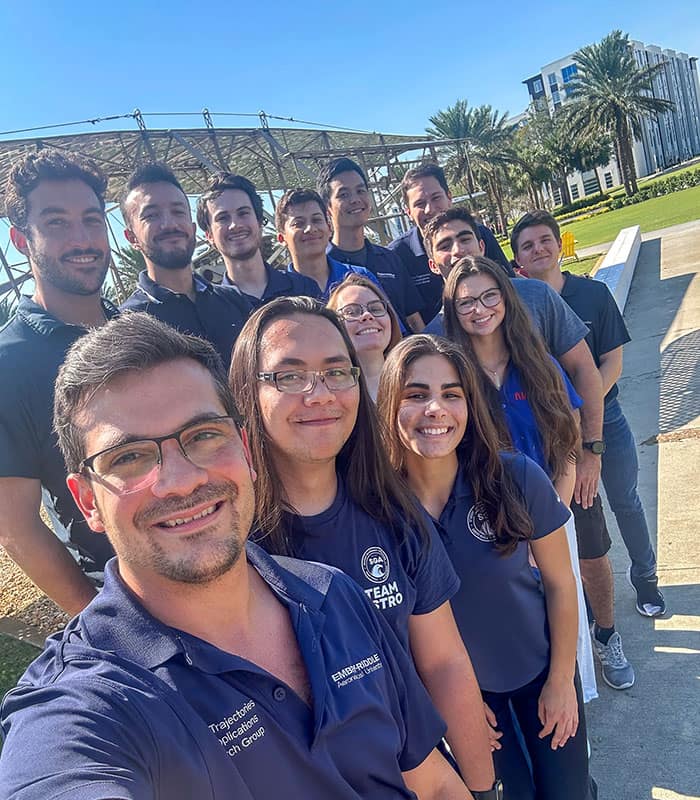Embry-Riddle Student Group Researching Space Operations Lands Papers in Top Journals

Embry-Riddle graduate researcher Brian Baker-McEvilly has published a comprehensive review of space initiatives being undertaken in the region between the Earth and moon in the prestigious Progress in Aerospace Sciences (PAS), one of several Tier 1 publication successes to come out of Embry-Riddle’s Space Trajectories and Applications Research (STAR) group in the past year.
The paper, a collaboration with Purdue University researchers, “offers an extensive overview of the motivations, challenges and opportunities within the cislunar region. There’s no other paper in the literature that matches its comprehensiveness,” said Dr. David Canales Garcia, assistant professor of Aerospace Engineering and director of the STAR group. “For aerospace engineering, PAS is considered the No. 1 journal in which to have a paper published. We aim to maximize the visibility and impact of Brian’s work, ensuring that whenever cislunar activities are discussed in the literature, Brian’s paper is cited.”
Baker-McEvilly, who was first author on the paper, said that in general his research “aims to improve knowledge of all objects operating in the Earth-Moon system through the implementation of spacecraft with the capabilities to observe and track objects. More specifically, I investigate the best orbital trajectories to place those spacecraft in and the performance of the spacecraft to detect objects from those trajectories.”
He calls the research work he does in the STAR group “difficult and heavy at times” but adds that “the projects contribute to my development through opportunities to apply new skills, tackle problems that are important in industry and network with other researchers and professionals.”
Canales founded the STAR group two years ago. In just the past year, six papers that came out of STAR have been published in Tier 1 journals, a distinction meaning they are considered the most impactful journals in the field. In the past couple of months, two more STAR research papers have been accepted for publication.

STAR student researcher Suer Gi Jo presents research at the 2024 AAS/AIAA Astrodynamics Specialist Conference in Broomfield, Colorado. (Photo: Embry-Riddle)
“I believe this is a testament to the quality of work our students are producing. We are trying to be very productive in the field of cislunar expansion and operations,” Canales said, adding that one of the student researchers, Joseph Anderson, was able to lead a discussion on STAR’s augmented reality design work in company meetings when he was interning at Northrop Grumman. Anderson was named to the 2024-2025 NASA Florida Space Grant Consortium Masters Fellowship Program in August.
"I commend Dr. Canales and the STAR group," said Dr. Jeremy Ernst, Embry-Riddle's vice president for research and doctoral programs. "STAR provides the structure and guidance for students to apply unique skills and knowledge to make significant research contributions."
STAR student researcher Annika Anderson had work published earlier this year in the Celestial Mechanics and Dynamical Astronomy journal. Her research seeks to undo some common “close enough” simplifications used in planning space missions.
In the cislunar region, “a famously complex region in which to model dynamics,” Anderson said, “I want to undo one of the most common simplifications in the field of astrodynamics — assuming a spacecraft, Earth and the Moon have no shape or geometry and reducing them to be point masses — so we can get an accurate sense of where the spacecraft is pointing” and therefore a more accurate model of the spacecraft’s motion for the purpose of mission planning.
Franco Criscola, another STAR student researcher, also served as the first author of a paper that was published in Celestial Mechanics and Dynamical Astronomy. One focus of Criscola’s research is designing the path and orbit for a spacecraft that will study the solar wind, solar corona and solar energetic particles.
Working in the STAR group, Criscola said, “is really shaping my knowledge and interests. It is hard to imagine how I could go into the industry without having joined STAR. And it has given me a lot of contacts across the industry that I can leverage to grow in the future.”

 Michaela Jarvis
Michaela Jarvis